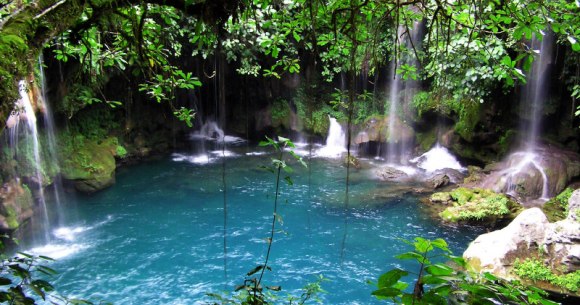Route 6
The Huastecas and their Outstanding Beauty
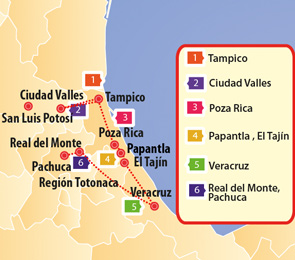 Tampico
Tampico
Framed by an imposing bridge, Tampico is characterized by a neoclassical architecture similar to that found in New Orleans, and also by its rich gastronomy. On Juarez street, there are handicrafts based on the city’s motto: ‘historical and maritime’. The visitor can explore Colonial places such as the Plaza de Armas and the Inmaculada Concepción cathedral, or modern structures like the Espacio Cultural Metropolitano (Metropolitan Cultural Space). And for those interested in ecotourism, the nearby Del Carpintero lagoon is refuge for several bird species.
Grilled meat tampiqueña style is delicious, but stuffed baked crabs, in patties or plain, mullet ceviche, shrimp empanadas, seafood envuelto, or bocoles with beef or pork are the specialties here.
In Tampico, the beach is near Ciudad Madero, and is called Miramar. A few minutes from the center of the city extends dozens of kilometers of fine sand and pleasant sea, on the panoramic highway of the Gulf of Mexico. It has been promoted heaviy recently and now boasts more facilities. A spot for leisure and gathering for the port’s inhabitants, Miramar complements its tangle of parasols and palapas with water sports.
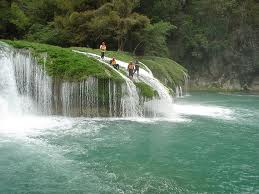 Ciudad Valles
Ciudad Valles
At the banks of the Valles river, a tributary of the Panuco, this important agricultural and livestock center has attractive tourist services, like the ecological reserve Abra-Tanchipa, rich in caves where it is possible to enjoy activities such as kayaking and rafting. Its vegetation and intense humidity explain the buoyant flora that stands out in the streets and around them. In neighboring areas, there are rivers and waterfalls – like Micos – that are worth a visit.
Ciudad Valles has the luck of being located in the middle of a region with incredible natural attractions. Quite close to the city there are sulfur-thermal waters in Taninul. On the periphery, however, is where we’ll find the true ecological treasures of the area: waterfalls. At a distance of 25 kilometers, Micos waterfall showcases seven falls connected in the shape of a natural park. Minas Viejas presents some of the most beautiful pools in the Huasteca, as well as the 40 meter fall that recharges its turquoise waters.
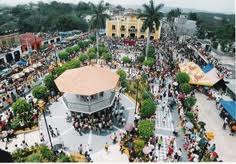 Poza Rica
Poza Rica
Poza Rica enjoys a privileged climate, with annual average temperature of 24 degrees Celsius (around 75 ºF). This is the departing place for the routes that lead the traveler towards the Huasteca and archaeological sites in the state. For the more adventurous, rafting in the Filobobos river is a very attractive option. The mural on the façade at the Municipal Palace, created by Pablo O’Higgins, is breathtaking, and at Juárez Park, you can dance danzon every Thursday. In March, the Carnaval del Petróleo (Petroleum Carnival) takes place, an ideal moment to taste local dishes.
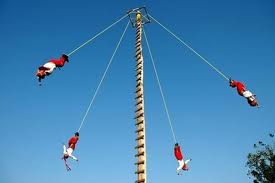 Papantla
Papantla
If the lovely and nearby beaches of Barra de Cazones and Tecolutla are not enough to quiet the spirit, any time you’re in Poza Rica, you can go to Tamiahua. On the road, you will find Tuxpan, which also has a beach on the river by the same name. Some 40 kilometers ahead, where the sea becomes lagoon, you will find this tangle of swamps, islets, beaches and land stretches called Tamiahua. The area will strike you with its wild beauty, which is well worth the trip.
Many travelers who only go to Tajín make the mistake of missing out on this Pueblo Magico. The parish of Nuestra Señora de la Asuncion, the monument to the volador (person who flies), and its markets – where you can taste dishes like the delicious zacahuil – in addition to its lovely streets, are places where you can spend an unforgettable afternoon. At the town hall, it is possible to hire the services of a local guide: they know every corner of the town and its surroundings, such as household vanilla plantations or ranches like El Gaya, where you can buy natural vanilla.
Totonacas is a culture of dance and music. In Papantla, many of their ancient traditions in music and dance are kept alive and thriving. If we consider the very famous Voladores (flying men) as performers of an acrobatic dance, we will find in this ritual their most celebrated ceremony. Another renowned ceremonyl is that preformed by los guaguas, also of Pre-Hispanic roots. The santiagueros come from the tale of colonial times and African negritos echo the slavery in New Spain.
The ritual of Papantla’s Voladores (flying men) is included in one of the designations made by UNESCO, that of Intangible Cultural Heritage. The tradition of this spectacular ceremony has extended from Totonac Papantla, as far as Central America. A mix of music, mysticism and acrobatics, the ceremony links a pure respect for the nature to the spiritual world. In the hypnotic evolution of flyers from the heights, humanity conserves myths about the origin of the world and makes an offer of incomparable beauty.
El Tajin
This is the ancient capital of the Totonac state, a UNESCO World Heritage site, whose names means “City of Thunder” in the original language. The niche pyramid, emblematic of the site, is a Pre-Hispanic piece of astronomical connotations and great construction. Each March, the Cumbre Tajín takes place, a festival that celebrates Pre-Hispanic identity and heritage. Around the archaeological site, vendors offer fresh vanilla and handicrafts.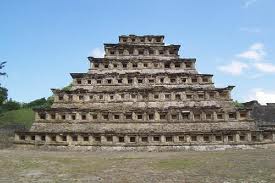
There are many pyramids in Mexico, but none like the Temple of the Niches in El Tajin. All visitors will notice ‘windows’ on the side of its structure, but in reality they are 365 niches minus the staircases. The city, together with Teotihuacan, made up the most important urban twin settlements in the Mesoamerican northeast, from 900 to 1100 AD. The foundation of the society collapsed for reasons still unknown, and was set on fire. A Spanish officer found the forgotten buildings in 1785 – while looking for illegal tobacco plantations.
It was fortunate for coming generations that El Tajin, after its fall, was forgotten and claimed by the jungle. This allowed it to survive the Conquest practically intact, as well as the long Colonial Era. In 1992, UNESCO declared it to be a World Heritage Site, since its cultural influence – at the time of its peak – was extended along the Gulf to the Mayan zone and to the inland highlands. Its architecture, with friezes and bas reliefs, stands out as unique in Mesoamerica. We must thank nature for preserving the “City of Thunder” for the future.
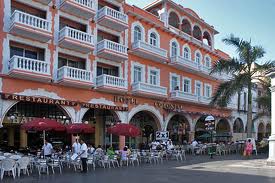 Veracruz
Veracruz
The most important maritime commercial port in Mexico, Veracruz is an essential place to visit for people who are passionate about history; one must visit the prison of San Juan de Ulúa, full of legends, and a nearby little town where the ruins of the Conquistador Hernán Cortes’ house are found. The white walls, the aroma of coffee and the marimba sounds in the pier steal sighs from visitors. In addition to its famous coffee houses, the culinary offerring from Boca del Río stands out.
Around Veracruz, there are towns that have achieved fame and fortune by working the fertile ground and conserving nature. To the south, at the Tuxtlas Biosphere Reserve, there is an ecological treasure of rainforest and volcanoes that complements the mystical ambiance in Catemaco. To the Northwest, you will find Xalapa and especially Coatepec – Pueblo Magico since 2006 –, which describe the history of what was once the coffee-production epicenter in the continent. Going west, near Huatusco, the best sustainable tourism in the country protects the flora found in the cloud forest.
The port in Veracruz synthesizes all the gastronomy from the state, particularly its very famous marine roots. Seafood is lovingly prepared, and consumed, in dishes like shrimp empanadas, mullet roe patties, seafood casseroles or octopus marinera style. Rice tumbada style and anise or costeño tamales complete the job, accompanied by glorias, toritos, diablitos and other drinks that always end in coffee at the port. Although “fish Veracruz style” has become a cliché, leaving without tasting the red snapper is a mistake.
This port, four times heroic, is considered the entryway to Mexico; through it passed the fierce Conqueror and, eventually, kindly, the whole world. The music and dances are metaphors of this history of contacts. Son jarocho and fandango have the Spanish vein of footwork in zapateado, as well as sweet notes on the harp and the jarana accompanied by violin. In the traditional dance, danzon, it incorporates Cuba and all of the Caribbean essence, with metal sounds and intimate seduction in the steps. And more common, yet also beautiful, is the sound of marimbas: the street soundtrack in this Villa Rica of Vera Cruz.
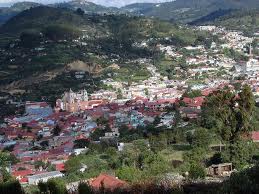 Real de Monte
Real de Monte
This is one of the highest, inhabited places in the Mexican Republic. Its cold climate, mountain vegetation, and English style architecture prevail in this Pueblo Magico. Elevation here is at around 9,000 feet with a population of around 10,000 people. Only 10 minutes away from Pachuca, this picturesque town, where the first soccer game in Mexico was played, is also the birthplace of the traditional paste. The Acosta mine is one of the most emblematic in the region, and a visit to the Mineral del Chico National Park, a few kilometers away, is also worth a visit, somewhere ideal for camping and hiking.
Pachuca
The legacy of the Industrial Revolution is still evident in this city’s streets. The excavation tradition that arrived with the English during the second half of the 19th Century can be seen in the Miner Museum, while the Barreteros Market is full of local handicrafts and delicious options for tasting barbacoa, the state’s specialty. The clock that commemorates the first anniversary of the Independence is the culminating place of La Bella Airosa (the city’s nickname, meaning elegant and beautiful), which can be contemplated in its totality from the viewpoint on the road to Real del Monte.
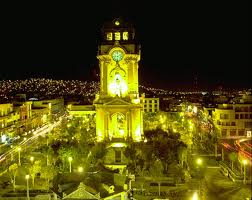 Pachuca de Soto is the place where Mexican soccer was born, of long mining tradition; in addition to minerals, it has gastronomy that comes from very far and very near. From the indigenous people, it takes subtleties like escamol and chiniquil, and maguey worms. From the New Spain or mestizo heritage, there is barbacoa and cecina. And from beyond the sea, imported from Britain, are pastries – known as pastes –, which have given the city a fame only surpassed by their passion for soccer.
Pachuca de Soto is the place where Mexican soccer was born, of long mining tradition; in addition to minerals, it has gastronomy that comes from very far and very near. From the indigenous people, it takes subtleties like escamol and chiniquil, and maguey worms. From the New Spain or mestizo heritage, there is barbacoa and cecina. And from beyond the sea, imported from Britain, are pastries – known as pastes –, which have given the city a fame only surpassed by their passion for soccer.
Huasteca Potosina
In addition to waterfalls, rivers and lagoons formed by the warmth and humidity of this region, this place is home to places with unbelievable natural landscapes, like the Sótano de las Golondrinas (Swallow’s Basement), the most beautiful vertical cave in the world, where various types of birds nest. And what can we say about Xilitla? This is the small town where the surrealist artist Sir Edward James, a friend of Salvador Dalí’s, created structures that are apparently absurd but which blend into nature in a welcoming manner.
Ecotourism around the Huasteca in San Luis Potosí definitely has an aquatic character, for the region is known for the profusion of water bodies and active currents. So, in Tamasopo the trend is riverside resorts and swimming in pools at the foot of the falls, Cascadas del Pueblo. At Puente de Dios you will find the so-called Poza Azul – blue pool, which is true to its name – and the possibility of swimming among stalactites. You can canoe down the waters of river Tampaón and, with some luck, visit Cueva del Agua (Water Cave); upstream you will find the famous waterfall, Tamul.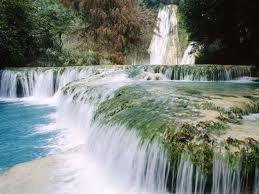
Ciudad Valles is the logical base for exploring the Huasteca in San Luis Potosí, to tour the natural beauties in the area. Going north, the Abra-Tanchipa ecological reserve is located, on the northern edge of tropical forests, keeping threatened species safe among caves. To the west, you will find Puente de Dios, this exceptional erosive formation flanked by pools filled with intensely blue waters. And, the greatest award waits to the east: the sight of 105 meters of water plunging in the spectacular Tamul waterfall.
Totonaca Region
This fragrant territory, where vanilla is cultivated, is rich in culture, nature and history.. The archaeological site of El Tajín houses imposing and beautiful Pre-Hispanic constructions; Papantla is a Pueblo Mágico famous for the adventurous voladores (flyers) that come from there; Costa Esmeralda has beautiful beaches with blue-green waters; and the Filibobos river is ideal for lovers of adventure tourism. All this as well as delightful food including; fresh seafood (chilpachole de acamayas is a delicacy) and sweets like cocadas, or tortilla chips with panela cheese.
Known by the Mexicas as Totonacapan, the ancient perimeter of Totonaca influence used to extend from El Tajin and Papantla, in the north, and through Xalapa to the southern Cempoala. With very large cities – Xalapa reached 120 thousand inhabitants at some point – this region is tragically famous for being the first that the Spanish Conquerors destroyed. Today, the fierce El Tajin survives, and at the “place of the twenty waters”, there are stone vestiges that remind us of the Totonaca glory.
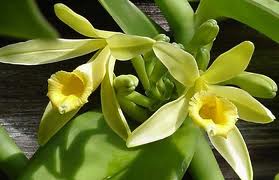 Southeast from Papantla, you can find the best version of the Gulf of Mexico, on the brownish sands and blue-green waters of the Emerald Coast. There, from the town of Tecolutla, you can hire boat rides along the river by the same name and to the Lagartos swamp. Further south you’ll find the Tres Encinos and Barra Nueva swamps, quite close to Nautla. Inland from here, there is Filobobos eco-archaeological reserve, a famous destination for rafting and adventure tourism. If you do not want to descend the rapids, El Encanto waterfall will justify your trip by staying true to its name (The Charm).
Southeast from Papantla, you can find the best version of the Gulf of Mexico, on the brownish sands and blue-green waters of the Emerald Coast. There, from the town of Tecolutla, you can hire boat rides along the river by the same name and to the Lagartos swamp. Further south you’ll find the Tres Encinos and Barra Nueva swamps, quite close to Nautla. Inland from here, there is Filobobos eco-archaeological reserve, a famous destination for rafting and adventure tourism. If you do not want to descend the rapids, El Encanto waterfall will justify your trip by staying true to its name (The Charm).
In the Totonacapan region, culinary tradition stems from a very ancient culture, of strong temperament. The basis of popular food is black beans and dishes derived from them, which can be prepared with alchucut, boiled ejote recio, in huatape or púlakles with pipián, chilcotes, acoyo and salt. Hen stews, taxwayahun – a pork dish –, wild meat and shrimp mole or izote flowers complement. Turkey mole, dry pork patitas and fish tamal are in a league of their own, for they are true jewels of Totonaca cuisine.
Huapango, or son huasteco, is the native musical genre of the area made up of northern Veracruz, southern Tamaulipas, Queretaro’s Sierra Gorda and parts of the states of San Luis Potosi, Hidalgo and Puebla. Each region contributes a special nuance, but essentially it is a concert of guitars, jaranas, violins and quintas huapangueras, accompanied by footwork (zapateado) and melodic singing. Of extraordinary beauty this music and its dance manifest deep indigenous, Spanish and even African roots.
In the Totonaca Region, the leading natural attractions above all others are the pastoral beauty of the Emerald Coast and the vertiginous path of the Bobos river. On the first, we can expect 20 kilometers of sand cut against a sea of transparent waters that tend to green, from which it receives its name. In the second, running downhill from the highest peaks in Mexico, a landscape of ravines, waterfalls and rock meanders cross the fertile tropical flora – and many archaeological sites – until they come to an end in Nautla.
To book a trip through the Route 6 Region, please send us an email to; info@weareonetravel.com or fill in the Contact Form on the right hand side of this page.
